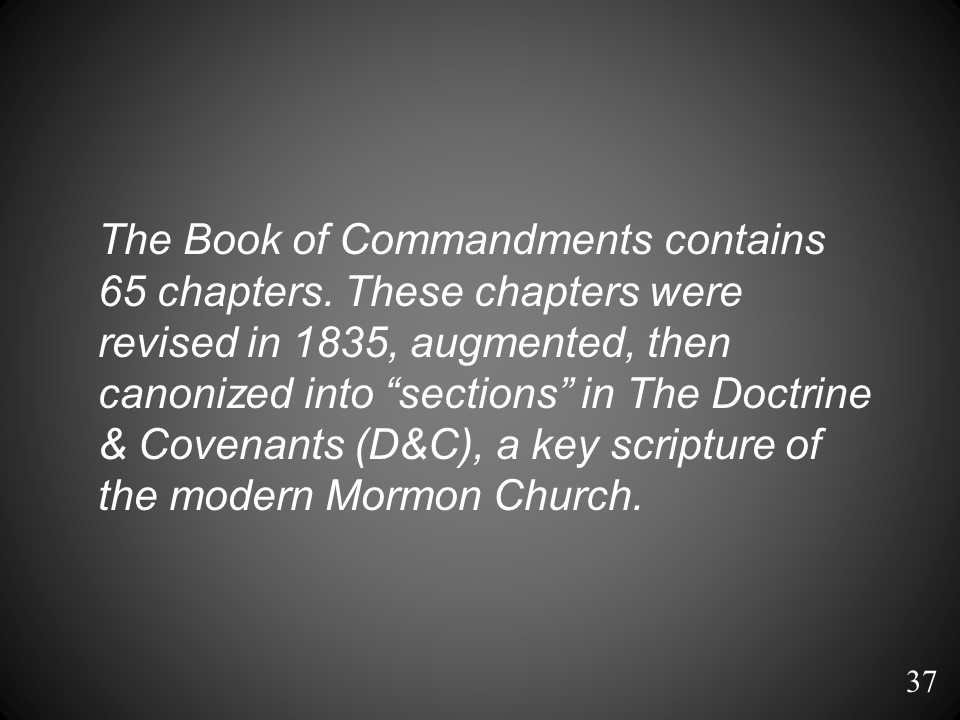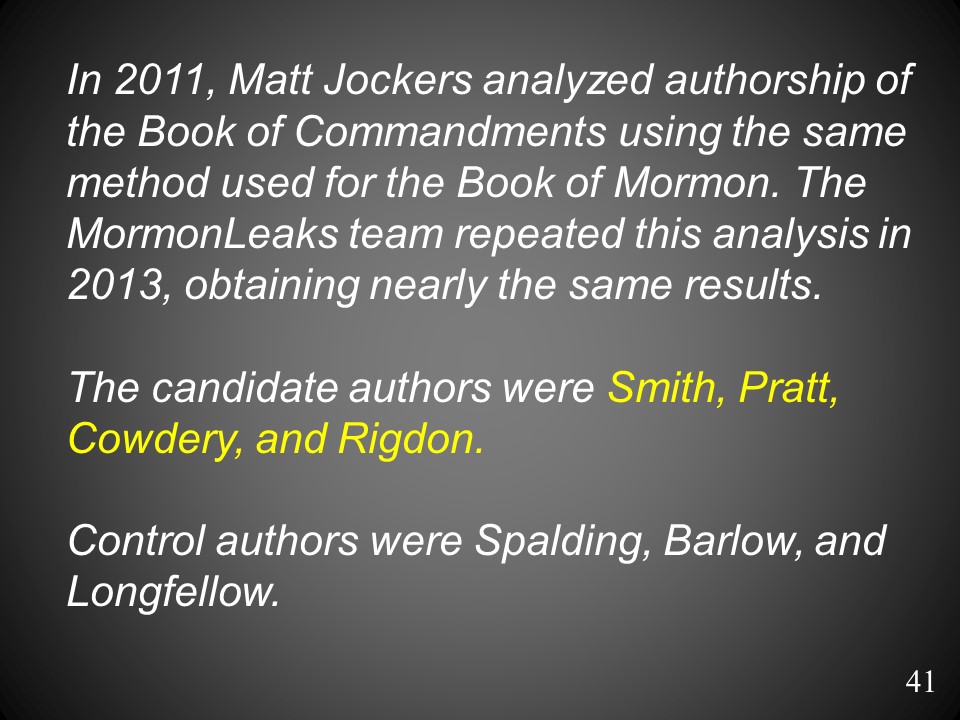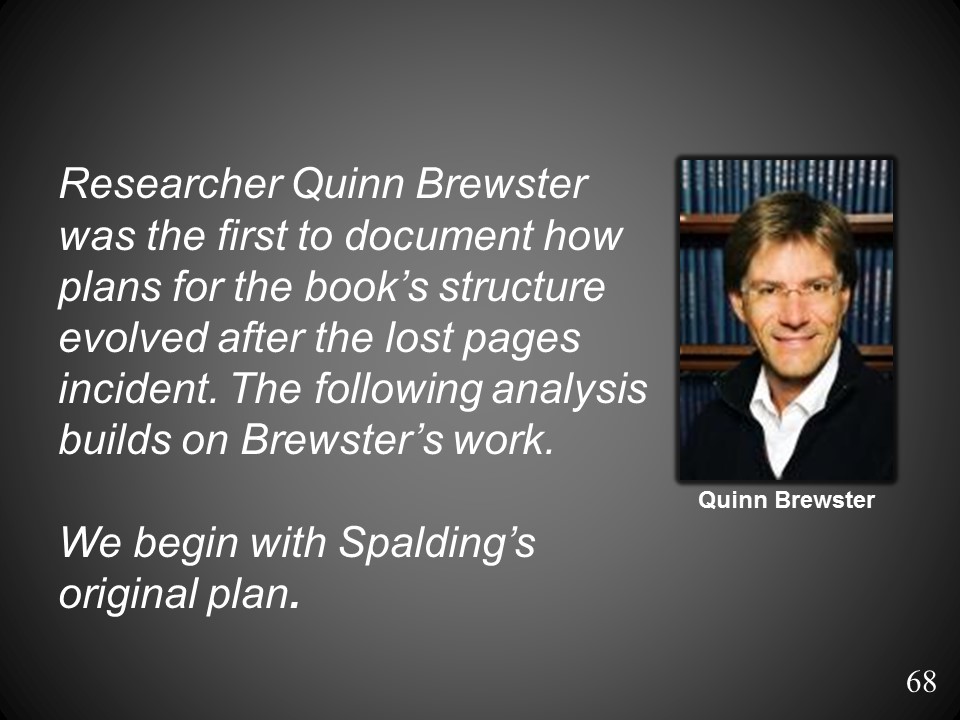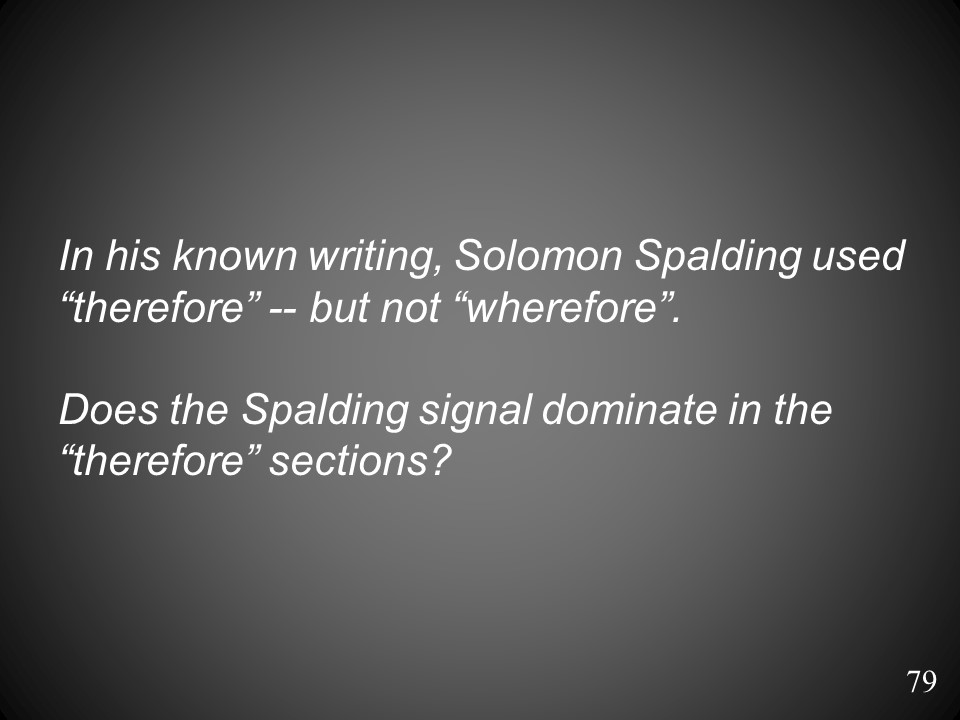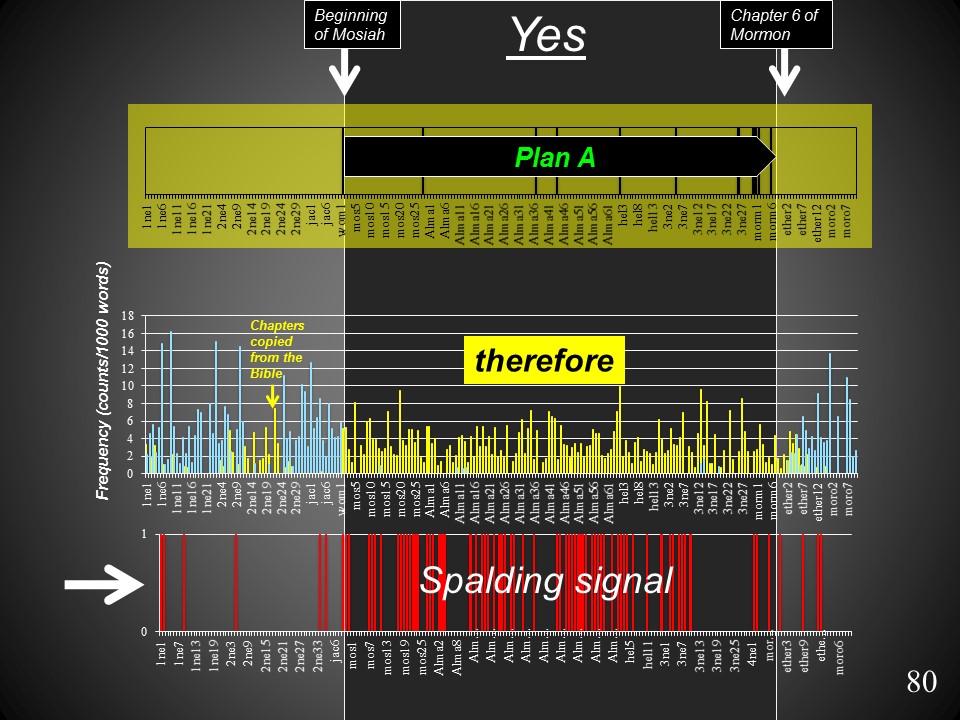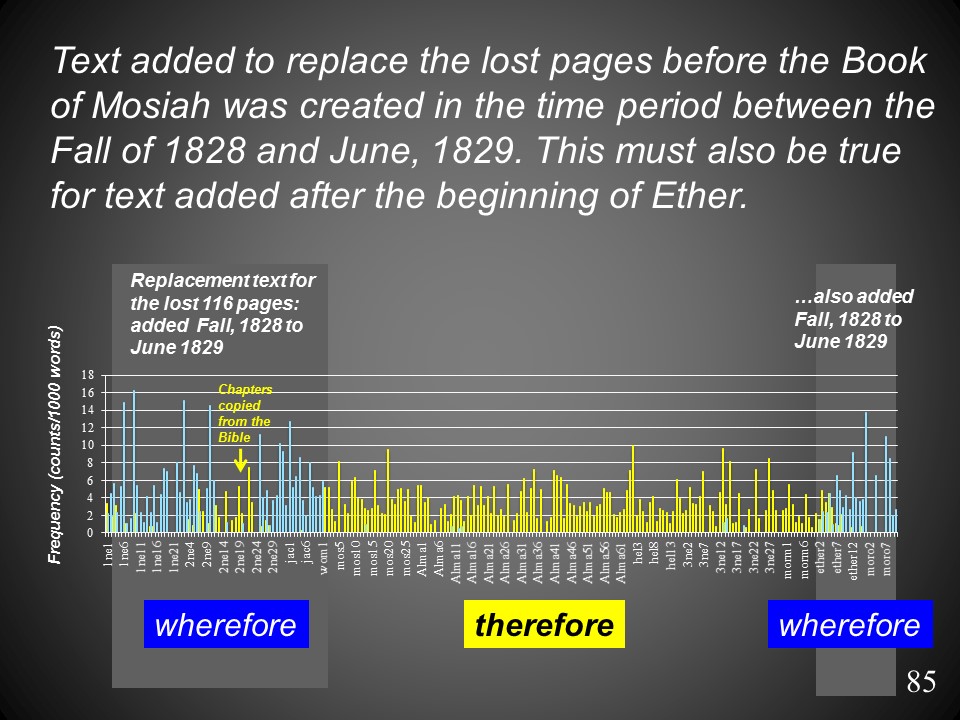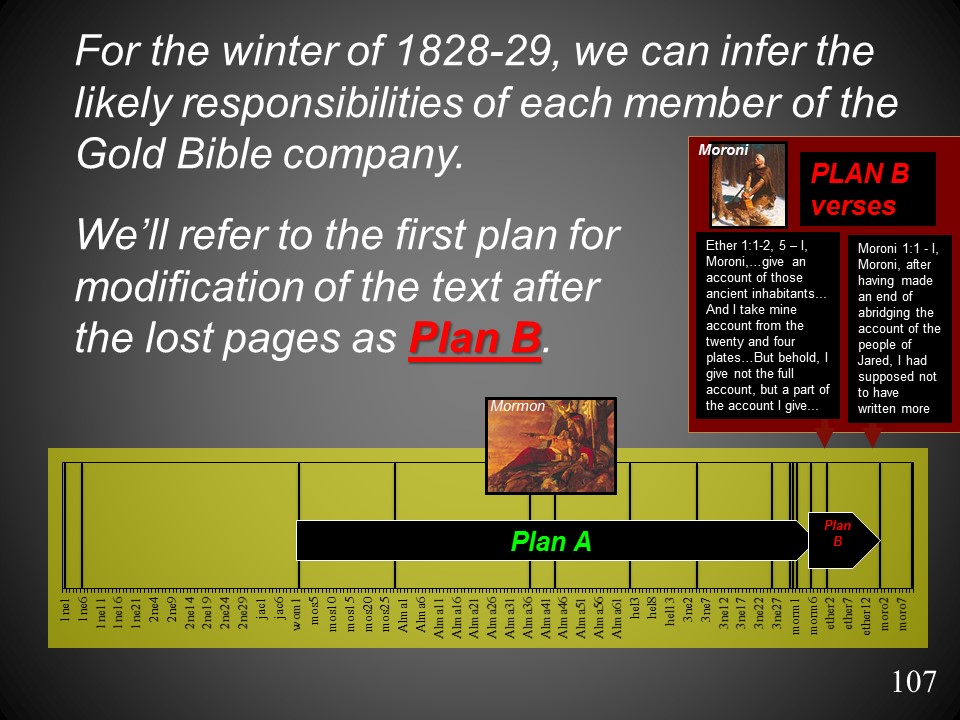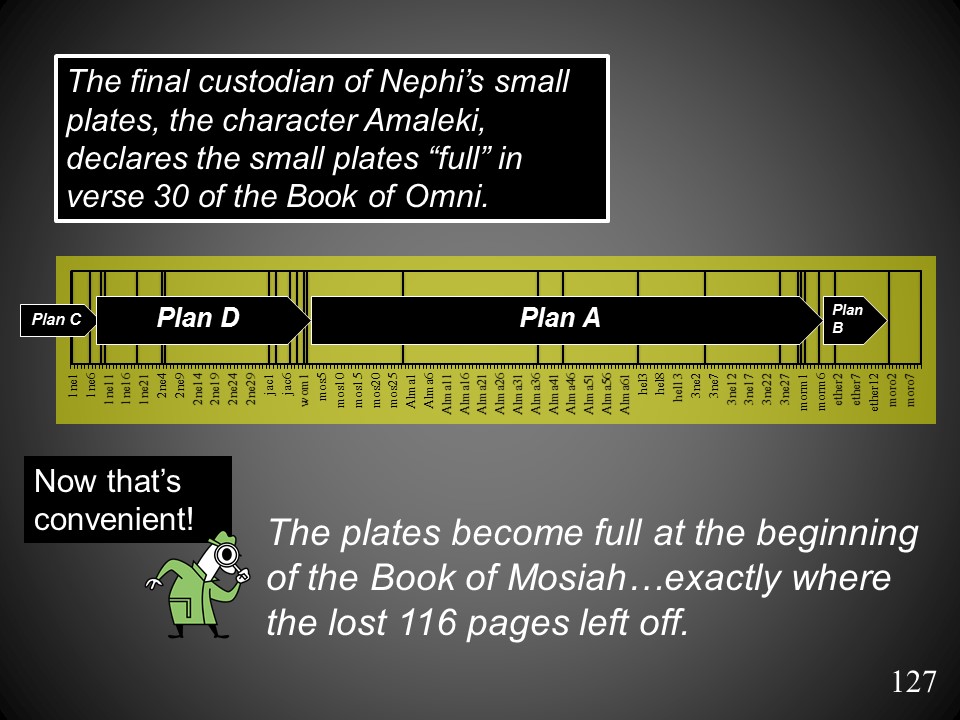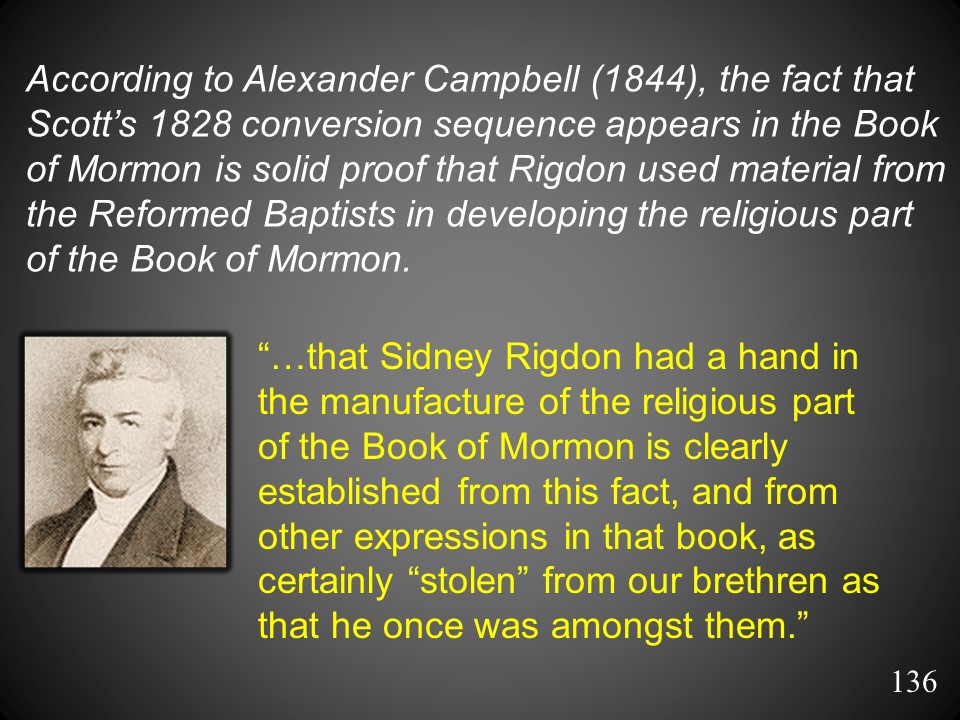Episode 5
Episode 05 – Slide 4
“It [the Book of Mormon] is too complex to have been written by Joseph in the manner and in the amount of time described by witnesses. Indeed, it is too complex to have been written by Joseph in the manner hypothesized by his enemies or critics. Ultimately, it appears to be too complex to have been written by Joseph or any of his contemporaries in the early nineteenth century under any conceivable set of circumstances other than the one Joseph describes — the translation by miraculous means of an authentically ancient document.”
http://maxwellinstitute.byu.edu/publications/books/?bookid=41&chapid=186
Mormon Apostle Dallin Oaks:
“Our side will settle for a draw, but those who deny the historicity of the Book of Mormon cannot settle for a draw. They must try to disprove its historicity–or they seem to feel a necessity to do this–and in this they are unsuccessful because even the secular evidence, viewed in its entirety, is too complex for that.”
Mormon apologist and BYU professor Daniel C. Peterson has said:
“The intricate structure and detailed complexity of the Book of Mormon seem far better explained as the work of several ancient writers using various written sources over the space of centuries than exploding suddenly from the mind of a barely educated manual laborer on the American frontier.”
Episode 05 – Slide 6
http://sidneyrigdon.com/criddle/rigdon1.htm#22
Samuel F. Whitney:
“I heard Sidney Rigdon preach… in 1827 or ’28. He said how desirable it would be to know who built the forts and mounds … Soon it would all be revealed.”
John Rudolph:
“For two years before The Book of Mormon appeared Rigdon’s sermons were full of declarations and prophecies that the age of miracles would be restored, and more complete revelations, than those in the Bible, would be given.”
Reuben Harmon:
“I was personally acquainted with Rigdon….I have heard [him] several times say in his sermons that before long the Indian mounds and forts about there would all be explained.”
Adamson Bentley, Rigdon’s brother-in-law, wrote to Walter Scott on Jan 22, 1841:
“I know that Sidney Rigdon told me that there was a book coming out, the manuscript of which had been found engraved on gold plates, as much as two years before the Mormon Book made its appearance, or had been heard of by me.”
Episode 05 – Slide 7
“During this state of unexampled success, the prospect of wealth and affluence was fairly open before him; but he looked upon it with indifference, and made every thing subservient to the promotion of correct principles: and having food and raiment, he learned therewith to be content. As a proof of this, his family were in no better circumstances, and made no greater appearance in the world, than when he labored at the occupation of tanning. His family consisted of his wife and six children, and lived in a very small, unfinished frame house, hardly capable of making a family comfortable; which affords a clear proof that his affections were not set upon things of a worldly nature, or secular aggrandizement.”
Episode 05 – Slide 9
Smith family financial situation: In 1823, work on a frame house at the Smith family farm was halted by the unexpected death of Smith’s eldest son, Alvin. Smith subsequently failed to make payments on the farm.
According to Donna Hill (1977):
“The basic structure of their new home had been finished some two years before. Recently they had done the finishing touches on it with the help of a hired carpenter named Stoddard, and according to Lucy were now within a few months of the last payment on the farm, although . . . no evidence has been found that they had a formal contract for it.”
Lucy Smith reported that Stoddard offered $1,500 for the house, but the Smiths declined to sell. Stoddard and two associates told the Smiths’ agent in Cananadaigua that Joseph Sr. and Joseph Jr. had run away and that Hyrum was defacing the farm and cutting down the sugar trees. This persuaded the agent to give Stoddard the deed to the property upon immediate payment. Stoddard then offered the deed to the Smiths for $1,000. The Smiths did not have the funds, so they persuaded Lemuel Durfee to buy the farm. Durfee took ownership on December 20, 1825, for $1,135.” Durfee allowed the Smiths to remain in the frame house and on the farm. According to Lucy Smith, Durfee “gave us the privileage [sic] of the place one year with this provision that Samuel our 4th son was to labor for him 6 months.”
http://signaturebookslibrary.org/?p=8661
According to Hill:
“Lemuel Durfee gave the Smith’s a lease on the house and they would remain in it another three years, until December 30, 1828, when they would move to another house a little farther south.”
Reference: Hill, Donna (1977). Joseph Smith, the First Mormon. Garden City, N.Y.: Doubleday. p. xii. ISBN 0-385-00804-X.
Historian H. Michael Marquardt wrote:
“Lucy Mack Smith mentions in her history that in 1829 her family had moved out of the frame house, which belonged to Lemuel Durfee and his heirs, and went back into their previous log house in the township of Manchester where Hyrum Smith and his family had been living. . . . In this building, Oliver Cowdery prepared the ‘Book of Mormon’ printer’s manuscript in 1829-30 and here individuals visited the Smith family until the Smiths moved to Waterloo, New York, in the fall of 1830.”(H. Michael Marquardt, “An Appraisal of Manchester as Location for the Organization of the Church”, Web version 2004, originally published in “Sunstone” 16 (February 1992): 49-57, at:
http://www.xmission.com/~research/about/manchester.htm)
Lemuel Durfee, Sr., died on 8 August 1829 (Wayne Sentinel 6, 14 Aug. 1829) shortly after completion of dictation of the Book of Mormon. The probate of the will of Lemuel Durfee, Sr., lists:
“One note signed by Joseph Smith [Sr.] and Abraham Fish, thirty-seven dollars and fifty cents with interest of $1.42 (Probate Papers, Surrogate’s Court, Wayne County Courthouse, Lyons, New York). On 19 January 1830, Lemuel Durfee Jr. brought suit before Justice of the Peace Nathan Pierce (Town Hall of Manchester, Manchester, New York against Joseph Smith, Sr., and Abraham Fish for $39.92).”
http://signaturebookslibrary.org/?p=8627
Pomeroy Tucker described the family’s Manchester cabin as:
“a small, one-story, smoky log-house, which they had built prior to removing there. This house was divided into two rooms, on the ground-floor, and had a low garret, in two apartments. A bedroom wing, built of sawed slabs, was afterwards added.”
“The Smith family’s place of residency after their move to the log house of Hyrum and his family is referred to in every case as Manchester. All of the Smiths’ legal and personal documents dating from 1829-30 are dated at Manchester. This includes Joseph Smith’s revelations; letters written by Oliver Cowdery while living with the Smith family; law suits against Joseph Sr. and Hyrum; the 1830 census; and the 1830 Manchester assessment roll where Hyrum Smith is taxed for fifteen acres on Lot 1.”
http://signaturebookslibrary.org/?p=8661#mormon47
Ages in late Dec 1828: Joseph Sr, born July 12, 1771 age 57; Lucy, born January 24, 1775, age 53; Hyrum, born February 9, 1800, age 28; Sophronia (married, not living with parents) May 17, 1803, age 25; Joseph, jr. (married, not living with parents), born December 23, 1805, age 25; Jerusha (wife of Hyrum), born Feb 15, 1805 age 23; Lovina (daughter of Jerusha, born Sept 16, 1827 age 1; Samuel (“Sam” or “Harrison”), born March 13, 1808, age 20; William (“Bill”), born March 13, 1811, age 17; Catherine, born July 28, 1813, age15; Don Carlos (“Carlos”), born March 25, 1816, age 12; Lucy, born July 18, 1821, age 7.
According to Larry Morris (2007), around January 1829:
“Joseph Sr. and Samuel made a trip to Harmony to visit Joseph and Emma. The details of the journey are not known, but they presumably traveled most of the 130 miles on foot, enduring harsh conditions during midwinter in upstate New York. “In January [Joseph Sr.] and Samuel [Smith] Came from Manchester to my house when I was Buisey a Drawing Lumber,” wrote family friend Joseph Knight Sr., who lived in Colesville, about twenty-two miles from Harmony. “I told him they had traviled far enough I would go with my sley and take them Down [to Harmony] to morrow[.] I went Down and found them well and the[y] were glad to see us[.] we conversed about many things. in the morning I gave the old man a half a Dollar and Joseph a little money to Buoy paper to translate[,] I having But little with me. The old gentlman told me to Come and see him once in a while as I Could[.]”
http://maxwellinstitute.byu.edu/publications/jbms/?vol=16&num=1&id=428
Episode 05 – Slide 12
“In January 1829 David Adams filed a complaint before a justice of the peace in Lyons for the debt that Lyman and Oliver owed him. After being served a summons, Lyman sent a representative to admit owing money on the note. Justice of the Peace Hugh Jameson rendered judgment against Lyman and Oliver, finding them liable for the balance of $17.65 owed on the $22.00 note (plus court costs of $1.76, for a total of $19.41).”
http://maxwellinstitute.byu.edu/publications/jbms/?vol=16&num=1&id=428
Morris (2007) continued:
“Although the exact sequence of events is not known, Oliver soon asked Joseph Smith Sr. to take him as a boarder “at least for a little while” until he became acquainted with other patrons in the district. Joseph Sr. agreed, and Oliver took up residence with Joseph and Lucy and their children Samuel (known as “Sam” or “Harrison”—his middle name), 20; William (“Bill”), 17; Katharine, 15; Don Carlos (“Carlos”), 12; and Lucy, 7. Sophronia, 25, and her husband, Calvin Stoddard, may have also been living with the family at this time. Samuel and Sophronia were most likely still recovering from their illnesses when Oliver moved in.”
http://maxwellinstitute.byu.edu/publications/jbms/?vol=16&num=1&id=428
Morris also claimed that:
“The family lived in comfortable quarters in the two-story frame home begun by Alvin in 1823 and completed about two years after his death (he had died November 19, 1823).”
This statement does not appear to be accurate: the family evidently lived in the log cabin, not the frame house.
http://maxwellinstitute.byu.edu/publications/jbms/?vol=16&num=1&id=428
Episode 05 – Slide 14
Smith’s financial situation after lost pages: According to Vogel (2004):
“Despite his [Smith’s] later assertion that he filled the season of penitence with farm work, Joseph and Emma found themselves in extreme poverty as winter approached. Emma’s family had little desire to help them, so Joseph reached out to his nearest friend, Joseph Knight. Knight remembered that Joseph and Emma came to Colesville about “the first of the winter of 1828” seeking financial help. “But I was not in easy circumstances,” he recalled, “and I did not know what [Joseph’s translation of the gold plates] might amount to and my wife and family [were] all against me about helping him.”
Recalled Joseph Knight:
“Now he [Smith] Could not translate But little Being poor and nobody to write for him But his wife and she Could not do much and take Care of her house and he Being poor and no means to live But work. His wifes father and family were all against him and would not h[e]lp him. He and his wife Came up to see me the first of the winter 1828 and told me his Case. But I was not in easy Circumstances and I did not know what it mite amount to and my wife and familey all against me about helping him. But I let him have some little provisions and some few things out of the Store a pair of shoes and three Dollars in money to help him a litle.”
Episode 05 – Slide 16
http://www.deseretnews.com/article/700171292/A-different-view-of-Lucy-Harris.html?pg=all
Title for this image: “Clutching the manuscript, Glynne Scholle plays the part of Lucy Harris, wife of Martin Harris at the performance of the Martin Harris Pageant: “The Man Who Knew” in Clarkston, Utah on Thursday, Aug., 13, 2009.”
Episode 05 – Slide 18
“His [Martin’s] whole object was to make money by it. I will have one circumstance in proof of it. One day, while at Peter Harris house, I told him he had better leave the company of the Smiths, as their religion was false; to which he replied, if you would let me alone, I could make money by it.”
Lucy also claimed to have been physically abused by Martin Harris. Later she said:
“Whether the Mormon religion be true or false, I leave the world to judge; for its effects on Martin Harris have been to make him more cross, turbulent and abusive to me. His whole object was to make money out of it. I will give a proof of this. One day at Peter Harris’ house (Abigail Harris’ husband) I told him he had better leave the company of the Smiths, as their religion was false. To this he replied, ‘If you would let me alone, I could make money out of it.’ It is in vain for the Mormons to deny these facts, as they are well known to most of his former neighbors.”
Mrs. Abigail Harris, Martin’s sister-in-law, said:
“… Martin Harris and Lucy Harris, his wife, were at my house [early part of winter, 1828]. In conversation with the Mormonites, she [Lucy Harris] observed that she wished her husband would quit them, as she believed it all false and a delusion. To which I heard Mr. Harris reply: ‘What if it is a lie; if you will let me alone I will make money out of it!’ I was both an eye- and ear-witness of what has been above stated, which is now fresh in my memory, and I speak the truth and lie not, God being my witness.”
Palmyra, Wayne Co. N. Y. 11th mo. 28th, 1833.
The above quotes are from Eber Howe. 1834. Momonism Unvailed, p. 254.
http://www.archive.org/stream/mormonismunvaile00howe#page/254/mode/2up
Episode 05 – Slide 21
Episode 05 – Slide 22
Episode 05 – Slide 23
http://images.fineartamerica.com/images-medium-large/5-stagecoach-19th-century-granger.jpg
Stage coach travel would take 1-2 days.
http://olivercowdery.com/history/Cdychrn1.htm
Timeline:
http://www.eldenwatson.net/BoM.htm
Episode 05 – Slide 24
http://files.restorationbranches.org/AD%201830-1844/Joseph%20Smith%20And%20His%20Progenitors.pdf
Also available at: Lucy Smith History, 1845, in Early Mormon Documents, Vol. 1, Dan Vogel Ed., Signature Books, Salt Lake City, 1996. p. 119
Episode 05 – Slide 27
“If our hypothesis is correct, then Joseph went immediately to Oliver at Geneva and urged him to drop everything and rush off to Ohio to fetch Rigdon so the three conspirators could decide what to do next. This process would have taken several weeks, and was probably not completed until the latter part of July…”
Episode 05 – Slide 28
http://www.olivercowdery.com/smithhome/1880Math.htm
The Sally McKune quote is also cited on p. 188 in “Who Really Wrote The Book of Mormon” by Cowdrey et al., (2005).
Episode 05 – Slide 29
http://www.olivercowdery.com/smithhome/1880Math.htm
This information is also given in “Who Really Wrote The Book of Mormon” by Cowdrey et al. (2005). p. 188.
Pomeroy Tucker reported that Lucy Harris burned the manuscript. This is claimed in: Tucker, Pomeroy (1867), Origin, Rise and Progress of Mormonism, New York: D. Appleton.
WR Hine (1885) reported that Lucy did not burn the lost 116 pages, but instead gave them to a Dr. Seymour, a local physician, who read them and shared them with his patients, Hine himself, and Hine’s daughter. This is reported in Arthur Deming Deming’s “Naked Truths About Mormonism, Oakland, California: Deming & Co., 1888 (printed on the Seventh Day Adventist Pacific Press)”:
“Soon I learned that Jo claimed to be translating the plates in Badger’s Tavern, in Colesville, three miles from my house. I went there and saw Jo Smith sit by a table and put a handkerchief to his forehead and peek into his hat and call out a word to Cowdery, who sat at the same table and wrote it down. Several persons sat near the same table and there was no curtain between them. Martin Harris introduced himself to me, and said they were going to bring the world from darkness into light. Martin’s wife cooked for them, and one day while they were at dinner she put one hundred and sixteen pages, the first part they had translated, in her dress bosom and went out. They soon missed the one hundred and sixteen pages and followed her into the road and demanded them of her. She refused, and said if it was the Lord’s work you can translate them again, and I will follow you to the ends of the earth. Dr. Seymour came along and she gave them to him to read, and told him not to let them go. Dr. Seymour lived one and a half miles from me. He read most of it to me when my daughter Irene was born; he read them to his patients about the country. It was a description of the mounds about the country and similar to the “Book of Mormon.” I doubt if the one hundred and sixteen pages were included in the “Book of Mormon.” After I came to Kirtland, in conversation with Martin Harris, he has many times admitted to me that this statement about his wife and the one hundred and sixteen pages, as above stated, is true.”
http://www.sidneyrigdon.com/dbroadhu/CA/natruths.htm#010088-2e3
In in “Who Really Wrote the Book of Mormon” (2005), p. 487, Cowdrey et al., reported that Dr. Ezra Semour lived in Broome Country.
Episode 05 – Slide 30
Episode 05 – Slide 31
Episode 05 – Slide 32
“When Joseph delivered the 116 pages of the translation to Martin Harris, his Plates, his Interpreters, and his gift were taken from him for some two months. He translated the entire book of Mormon by the use of a little stone he had in his possession before he obtained the plates.”
Episode 05 – Slide 33
Lucy Mack Smith, Preliminary Manuscript [1844—45], Church Archives (hereafter Preliminary Manuscript), in Anderson, Lucy’s Book, p. 424.
Episode 05 – Slide 34
http://www.fullerconsideration.com/sources.php?cat=HP-JMC
“…while he, Smith, was in Harmony, Pa., translating his book…that he joined the M[ethodist] [Episocpal] church. He presented himself in a very serious and humble manner, and the minister, not suspecting evil, put his name on the class book, the absence of some of the official members, among whom was the undersigned, Joseph Lewis, who, when he learned what was done, took with him Joshua McKune, and had a talk with Smith. They told him plainly that such a character as he was a disgrace to the church, that he could not be a member of the church unless he broke off his sins by repentance, made public confession, renounced his fraudulent and hypocritical practices, and gave some evidence that he intended to reform and conduct himself somewhat nearer like a christian than he had done. They gave him his choice, to go before the class, and publicly ask to have his name stricken from the class book, or stand a disciplinary investigation. He chose the former, and immediately withdrew his name. So his name as a member of the class was on the book only three days.–It was the general opinion that his only object in joining the church was to bolster up his reputation and gain the sympathy and help of christians; that is, putting on the cloak of religion to serve the devil in.”
Hiel and Joseph Lewis
30 April, 1879
Episode 05 – Slide 35
“I, with Joshua McKune, a local preacher at that time, I think in June, 1828, heard on Saturday, that Joe Smith had joined the church on Wednesday afternoon, (as it was customary in those days to have circuit preaching at my father’s house on week-day). We thought it was a disgrace to the church to have a practicing necromancer, a dealer in enchantments and bleeding ghosts, in it. So on Sunday we went to father’s, the place of meeting that day, and got there in season to see Smith and talked with him some time in father’s shop before the meeting. Told him that his occupation, habits, and moral character were at variance with the discipline, that his name would be a disgrace to the church, that there should have been recantation, confession and at least promised reformation-. That he could that day publicly ask that his name be stricken from the class book, or stand an investigation. He chose the former, and did that very day make the request that his name be taken off the class book.”
(The Amboy Journal, June 11, 1879, p.1)
Episode 05 – Slide 36
The Conversion of Oliver Cowdery, Larry E. Morris, Journal of Book of Mormon Studies: Volume – 16, Issue – 1, Pages: 4—17Provo, Utah: Maxwell Institute, 2007.
http://maxwellinstitute.byu.edu/publications/jbms/?vol=16&num=1&id=428
Footnote 7. Biographical Sketches, p. 126. Reconstructing a precise chronology for this time period is problematic because of differences in Joseph Jr.’s and Lucy Mack Smith’s accounts. Joseph said that “immediately” after his return to Harmony, in July 1828, the heavenly messenger returned the Urim and Thummim (which had been taken in consequence of Joseph “having wearied the Lord in asking for the privilege of letting Martin Harris take the writings”). Joseph then received the revelation now recorded in Doctrine and Covenants 3 through the Urim and Thummim. “After I had obtained the above revelation,” recorded Joseph, “both the plates, and the Urim and Thummin were taken from me again, but in a few days they were returned to me” (Joseph Smith, Manuscript History of the Church, Book A-1, Joseph Smith Papers, Church Archives [hereafter “Manuscript History”], in Dan Vogel, Early Mormon Documents [Salt Lake City: Signature Books, 1996—2003], 1:72—73 [hereafter EMD]).
Lucy, on the other hand, said in one portion of her reminiscences that the Urim and Thummim was returned on September 22, 1828, and that sometime after that, she and her husband visited Joseph (see Biographical Sketches, 126). Complicating the matter even further, she said in another part of her history that “nearly two months” had passed when she and Joseph Sr. decided to go to Harmony. Since Joseph apparently returned to Pennsylvania the first week of July, such reckoning places Joseph Sr. and Lucy’s trip south around the beginning of September rather than at the end of the month. I believe Lucy was simply mistaken about the September 22 date and that the plates and Urim and Thummim were returned to Joseph in July and that his parents visited early in September, arriving back in Manchester on or before September 11, the date when Gain C. Robinson visited the Smith family and charged Joseph Sr. for medicine (see note 10). This is one of a number of instances where a third-party account confirms details of Lucy Mack Smith’s history—rather impressive considering the fact that she dictated it in 1844—45.
Episode 05 – Slide 39
Episode 05 – Slide 45
http://www.wordle.net/
Episode 05 – Slide 48
Episode 05 – Slide 49
“Behold thou art Joseph, and thou wast chosen to do the work of the Lord, but because of transgression, if thou art not aware thou wilt fall, but remember God is merciful: Therefore, repent of that which thou hast done, and he will only cause thee to be afflicted for a season, and thou art still chosen, and wilt again be called to the work; and except thou do this, thou shalt be delivered up and become as other men, and have no more gift. And when thou deliveredst up that which God had given thee sight and power to translate, thou deliveredst up that which was sacred, into the hands of a wicked an, who has set at nought the counsels of God, and has broken the most sacred promises, which were made before God, and has depended upon his own judgement, and boasted in his own wisdom, and this is the reason that thou hast lost thy privileges for a season, for thou hast suffered the counsel of thy director to be trampled upon from the beginning.”
Episode 05 – Slide 50
http://maxwellinstitute.byu.edu/publications/jbms/?vol=16&num=1&id=428
Lucy Mack Smith, Preliminary Manuscript [1844—45], Church Archives (hereafter Preliminary Manuscript), in Anderson, Lucy’s Book, p. 424.
Episode 05 – Slide 52
http://www.boap.org/LDS/History/HTMLHistory/v1c3history.html
Cited in An American Prophet’s Record: The Diaries and Journals of Joseph Smith, ed. Scott Faulring (Salt lake City: Signature Books, 1989), p. 8.
Episode 05 – Slide 53
“Smith and Rigdon had an intimacy but it was very secret and still and there was a mediator between them and that was Cowdery. The [Spalding] manuscript was stolen by Rigdon and modelled over by him and then handed over to Cowdery and he copied them and Smith sat behind the curtain and handed them out to Cowdery and as fast as Cowdery copied them, they was handed over to Martin Harris and he took them to Egbert Granden [sic], the one who printed them, and Gilbert set the type.”
Pages 132-133 in True Origin of the Book of Mormon (1914) by Charles Shook.
Also cited on page 129 in H. A. David et al. (1997), “Who Really Wrote The Book of Mormon?”
Episode 05 – Slide 56
Now, behold I say unto you, that because you delivered up so many writings, which you had power to translate, into the hands of a wicked man, you have lost them, and you also lost your gift at the same time, nevertheless it has been restored unto you again: therefore, see that you are faithful and go on unto the finishing of the remainder of the work as you have begun. Do not run faster then you have strength and means provided to translate, but be diligent unto the end, that you may come off conquerer; yea, that you may conquer satan, and those that do uphold his work.
Episode 05 – Slide 57
Episode 05 – Slide 58
BoM chapter attributions for unique phrases in BC 9:
Rigdon – 85%
Spalding – 8%
Cowdery – 0%
Smith – 8%
Pratt – 0%
BoM chapter attributions overall:
Rigdon – 33%
Spalding – 35%
Cowdery – 13%
Smith – 10%
Pratt – 10%
“cunning plan” – 2 Ne 9: 28 (Rigdon)
“flattereth” – 2 Ne 28:22 (Rigdon)
“hen gathereth”- 3 Ne 10:4-6 (Spalding)
“true points of my doctrine” – 3 Ne 21:6 (Rigdon)
“I am Jesus Christ, the Son of God” – 3 Ne 11:39-40 (Rigdon)
“gates of hell” – 3 Ne 18:13 (Smith)
“scattering and gathering…remnant of the seed of Joseph” – 1 Ne 10:14 (Rigdon)
“establish my church” – 3 Ne 21:22 (Rigdon)
“harden not their hearts “ – 1 Ne 14:22 (Rigdon); 3 Ne 21:22 (Rigdon)
Episode 05 – Slide 61
John H. Gilbert repeatedly confirmed that Lorenzo Saunders had reported seeing Rigdon prior to 1830 (letter to James T. Cobb of Oct 14, 1879; and 1881 interview by William H. and Edmund L. Kelley; letter to Thomas Gregg, June 19, 1881).
Episode 05 – Slide 63
Referring to the lost 116 pages, Orsamus Turner asserted:
“It was agreed by the Smiths Cowdery and Harris, not to transcribe these again…”
(Turner, Phelps and Gorham, p. 214)
Episode 05 – Slide 66
William E. McLellan to Joseph Smith III, from Independence, Mo, Sept. 8, 1872:
“The Plates and gift of translation were returned to him [Smith], but not the Interpreters. He translated the entire book of Mormon by the use of a little stone he had in his possession before he obtained the plates.”
In an 1885 interview, Zenas H. Gurley editor of the RLDS Saints’ Herald, asked Whitmer if Joseph had used his “Peep stone” to do the translation. Whitmer responded:
“.. The “Interpreters” were taken from Joseph after he allowed Martin Harris to carry away the 116 pages of Ms [manuscript] of the Book of Mormon as a punishment, but he was allowed to go on and translate by use of a “Seers stone” which he had, and which he placed in a hat into which he buried his face, stating to me and others that the original character appeared upon parchment and under it the translation in English.”
Episode 05 – Slide 68
Episode 05 – Slide 69
http://solomonspalding.com/docs1/1897spld.htm
Episode 05 – Slide 70
John H. Gilbert to James T. Cobb, Feb. 10, 1879
“Your idea that the first start of the book was a money speculation, not a new church, is perfectly correct.”
Hiel Lewis to James T. Cobb, Sept. 29, 1879
The above quotes suggest that Smith’s likely motive during execution of Plan A was money. For Cowdery and Rigdon, mixed motives seem likely. Both men needed money. Rigdon surely would have wanted to use the book as a kind of confirmation of the Old Testament–an aid in his theological struggles with Campbell who dismissed the Old Testament prophets. Cowdery likely justified his efforts on the book as good for society. He could excuse the need for deception because the book was another testament of Jesus Christ.
Episode 05 – Slide 72
Complete quote:
“The angel…told him [Joseph] …to go ahead and translate, but not to translate that that was lost, but to begin where he had left off. He commenced, and when he got the record partly translated, persecution rose there, and he wrote for David Whitmer to come and take him to his house. David came, and he asked how he should carry the plates, and he was told they would be there when he got there, in the garden. When he got to Father Whitmer’s he found the records, as he had been told he would, and there he finished translating the Book of Mormon, and there is where the three witnesses were showed the plates by the angel, that turned the leaves over one by one… After that the eight witnesses saw the book, and turned it over leaf by leaf and saw the characters that were on them.”
Episode 05 – Slide 76
Episode 05 – Slide 81
9 chapters out of (66-17) = 9/49 x 100 = 18%.
Spalding frequency in Mosiah:
15/28 x 100 = 53%.
Episode 05 – Slide 87
On p. 104, Ronberg describes use of “after that”. On p. 105, he describes the evolution of “because that” as subordinate clauses: “One particularly important addition to the conjunctions was because. This comes from by (the cause) that.”
Episode 05 – Slide 88
Leviticus 13:7 – But if the scab spread much abroad in the skin, after that he hath been seen of the priest for his cleansing, he shall be seen of the priest again:
Numbers 30:15 – But if he shall any ways make them void after that he hath heard [them]; then he shall bear her iniquity.
Joshua 23:1 – And it came to pass a long time after that the Lord had given rest unto Israel from all their enemies round about, that Joshua waxed old [and] stricken in age.
Episode 05 – Slide 89
1 Ne 2:11 – they did murmur in many things against their father, because that he was a visionary man
1 Ne 3:23 – And after that we had gathered these things together…
1 Ne 3:30 – And after that the angel had spoken unto us…
1 Ne 4:19 – And after that I had smitten off his head…
1 Ne 4:20 – After that I had done this…
1 Ne 7:11 – …after that I had made bellowses…
1 Ne 11:9 – And it came to pass that after that I had seen the tree…
1 Ne 13:29 – and after that these plain and precious things were taken away…
1 Ne 15:17 – until after that they are scattered by the Gentiles
1 Ne 16:35 – and they did murmur against my father because that he had brought them out of the land of Jerusalem.
Ether 12:21 – and after that the brother of Jared had beheld the finger of the Lord
Ether 15:16 – and after that they had retired to their camps…
Moroni 2:2 – ye shall call on the Father in my name and after that ye have done this…
Moroni 6:4 – and after that they had been received unto baptism…
Episode 05 – Slide 98
http://www.solomonspalding.com/docs/1851Whig.htm
“Chaldea” refers to land in Southern Babylon bordering the Persian Gulf.
Fundamentalist Christian timelines date the dispersion from the Tower of Babel to around 2300 BC.
http://www.christianworldviewofhistoryandculture.com/historytimeline
Episode 05 – Slide 102
It is possible that in Spalding’s Manuscript Found, Mosiah II translated the Jaredite record and the brass plates was inserted before Alma. This would have resulted in a structure like this:
Book of Lehi
Book of Mosiah
Book of Moses
Book of Ether
Book of Alma
Book of Helaman
Book of Nephi
Book of Mormon
In the 1827, Book of Mormon, Rigdon may have deleted the Book of Moses to use it for future revelations, leaving the Book of Ether.
Book of Lehi
Book of Mosiah
Book of Ether
Book of Alma
Book of Helaman
Book of Nephi
Book of Mormon
Book of Moses – saved for later use as “brass plates”, modern revelation.
But after the lost pages, it may have made more sense to move the Book of Ether to after the Book of Mormon. But why?
To enable add-ons with Moroni?
After 1828, we end up with this:
Book of Lehi
Book of Mosiah
Book of Alma
Book of Helaman
Book of Nephi
Book of Mormon
Book of Ether
Book of Moroni
Episode 05 – Slide 104
Episode 05 – Slide 106
http://lareviewofbooks.org/article.php?id=1135
Pratt references Bunyon’s “The Pilgrim’s Progress” in the following excerpt from Chapter 32 of “The Autobiography of Parley P. Pratt”:
“No sooner was the key turned than the door was seized by Mr. Follett with both hands; and with his foot placed against the wall, he soon opened a passage, which was in the same instant filled by Mr. Phelps, and followed by myself and Mr. Follett. The old jailer strode across the way, and stretched out his arms like Bunyan’s Apollion, or like the giant Despair in Doubting Castle, but all to no purpose. One or two leaps brought us to the bottom of the stairs, carrying the old gentleman with us headlong, helter skelter, while old Luman sat and laughed in his comer of the prison, and Mrs. Phelps exclaimed, “O Lord God of Israel, thou canst help.” Old Mrs. Gibbs looked on in silent amazement, while the jailer’s wife acted the part of the giant Despair’s wife, Diffidence, and not only assisted in the scuffle, but cried out so loud that the town was soon alarmed. In the meantime we found ourselves in the open air, in front of the prison and in full view of the citizens, who had already commenced to rally, while Mr. Phelps and the jailer still clinched fast hold of each other like two mastiffs. However, in another instant he cleared himself, and we were all three scampering off through the fields towards the thicket.”
In 2009, BYU Profesor Royal Skousen reported 17th century writing patterns in the Book of Mormon. Prof. Skousen described these patterns in an article entitled “12 Questions and a Book”:
http://timesandseasons.org/index.php/2009/09/12-questions-and-a-book-by-royal-skousen/
In the above link, Prof. Skousen describes the critical text project for the Book of Mormon, and he is asked: “What are some of the major findings of this project?” He replied:
(a) The original manuscript supports the hypothesis that the text was given to Joseph Smith word for word and that he could see the spelling of the names (in support of what witnesses of the translation process claimed about Joseph’s translation – namely, that he spelled out the Book of Mormon names, at least when the name first appeared).
(b) The original text is much more consistent and systematic in expression than has ever been realized.
(c) There are a number of errors in the text that have never been corrected in any LDS or RLDS edition, although none of them fundamentally alter the text.
(d) There are occasional errors in the original manuscript itself (see, for instance, the reading “Ishmael and also his hole hole” in 1 Nephi 7:5); errors could enter the text from its very earliest transmission; many of the errors in the original manuscript show that this manuscript was written down from oral dictation.
(e) Errors in the printer’s manuscript clearly show that this manuscript was produced by visual copying from another text, not by oral dictation.
(f) Joseph Smith’s editing for the second and third editions (1837 and 1840) represents human editing, not a revealed revision of the text.
(g) The original text includes unique kinds of expression that appear to be uncharacteristic of English in any time and place; some of these expressions are Hebraistic in nature.
(h) The early transmission of the Book of Mormon text does not in general support the traditional assumptions of textual criticism – namely, the assumptions that the transmitted text tends to remove difficult readings and lengthen the text; instead, the early transmission of the Book of Mormon text tends to introduce more difficult readings and to omit words and phrases.
(i) The vocabulary of the Book of Mormon text appears to derive from the 1500s and the 1600s, not from the 1800s. This last finding is quite remarkable. Lexical evidence suggests that the original text contained a number of expressions and words with meanings that were lost from the English language by 1700, including the following (with the date of their last citation in the Oxford English Dictionary given in parentheses):
.to require ‘to request’ (1665) Enos 1:18 reads “thy fathers have also required of me this thing” [Ezra 8:22: “for I was ashamed to require of the king a band of soldiers and horsemen to help us against the enemy in the way”]
.sermon ‘talk, discourse, speech’ (1594) [conjectural emendation] Mosiah 19:24 should read: “after they had ended the sermon” (not the current reading “after they had ended the ceremony”)
.to cast arrows ‘to shoot arrows’ (1609) Alma 49:4 reads “the Lamanites could not cast their stones and their arrows at them” [Proverbs 26:18: “as a mad man who casteth firebrands arrows and death”]
.to counsel ‘to counsel with’ (1547) Alma 37:37 originally read: “counsel the Lord in all thy doings” [similarly in Alma 39:10]
but if ‘unless’ (1596) Mosiah 3:19 originally read: “for the natural man is an enemy to God …and will be forever and ever but if he yieldeth to the enticings of the Holy Spirit”
.to depart ‘to part’ (1677) Helaman 8:11 originally read: “to smite upon the waters of the Red Sea and they departed hither and thither”
.extinct: in reference to an individual’s death (1675) Alma 44:7 reads: “and inflect the wounds of death in your bodies that ye may become extinct” [similarly in several other places]
.the pleading bar of God (not in the Oxford English Dictionary, but three early 1600 citations have been found, including one in a legal context) [conjectural emendation] Jacob 6:13 should read: “until I shall meet you before the pleading bar of God”, not “the pleasing bar of God” [similarly in Moroni 10:34]
As noted, only two of these instances of archaic vocabulary (dating from Early Modern English) are found in the 1611 King James Bible.”
The two instances of Early Modern English vocabulary in the KJ Bible are “to require” and “cast arrows”.
Skousen’s identification of but if, sermon and to counsel as archaic phrases found in the Book of Mormon, but not in the KJ Bible, is of interest. John Bunyan used all these terms in “The Pilgrim’s Progress”:
“Then, said Evangelist, stand still a little, that I may show thee the words of God. So he stood trembling. Then said Evangelist, “See that ye refuse not him that speaketh. For if they escaped not who refused him that spake on earth, much more shall not we escape, if we turn away from him that speaketh from heaven.” [Heb. 12:25] He said, moreover, “Now the just shall live by faith: but if any man draw back, my soul shall have no pleasure in him.” [Heb. 10:38] He also did thus apply them: Thou art the man that art running into this misery; thou hast begun to reject the counsel of the Most High, and to draw back thy foot from the way of peace, even almost to the hazarding of thy perdition.”
“Yea, he did hold me to it at that rate also, about a great many more things than here I relate; as, that it was a shame to sit whining and mourning under a sermon, and a shame to come sighing and groaning home: that it was a shame to ask my neighbour forgiveness for petty faults, or to make restitution where I have taken from any.”
“The next night, she, talking with her husband about them further, and understanding they were yet alive, did advise him to counsel them to make away themselves.”
http://www.gutenberg.org/files/131/131-h/131-h.htm
http://records.viu.ca/~johnstoi/eng200/pilgrim.htm
In the “Acceptable Sacrifice”, Bunyan uses “cast arrows”:
“Men move not, they relent not, let God thunder never so terribly; let God, in the greatest earnest, cast abroad his firebrands, arrows, and death, in the most dreadful representations of wrath and judgment, yet still man trembles not, nor is any more astonished than if in all this God were but in jest, till he comes and falls to work with him, and forces him to cry out, What have I done? What shall I do?”
http://www.biblebb.com/files/bunyan/sacrifice.htm
In “The Work of Christ as an Advocate”, Bunyan refer to pleading at the “bar of God”:
“Wherefore he saith, “If any man sin, we have an Advocate”; one to stand up for him, and to plead for his deliverance before the bar of God.” (Joel 3:2. Isa 66:16. Eze 38:22. Jer 2.). In the same work, Bunyan uses the term “But it”: “But if it was to plead good causes for which Christ is appointed Advocate, then the apostle should have written thus: If any man be righteous, we have an Advocate with the Father.”
Episode 05 – Slide 111
The word “them” refers to two stone interpreters used for translation of ancient records.
Apologists will argue that Ether 4:1 was actually referring to Mosiah I who had received a large stone with Jaredite writings (Omni 21). This does not explain why a change was made in 1837.
Episode 05 – Slide 112
According to Ether 3, the plates and interpreters were buried together. The interpreters and plates should therefore stay together. But according to the text, King Limhi has the plates while King Mosiah II has the interpreters (Mosiah 8:13). King Limhi and King Mosiah II live in different lands.
Mormon apologists are aware of this problem. For an apologetic explanation, see:
http://oneclimbs.com/2010/08/25/interpreters-and-combinations/
“my theory is that Mosiah gets the interpreters from the people of Zarahemla who get them directly from Coriantumur; but that’s just a theory.”
This theory ignores Ether 3:23 which says that the the plates and interpreters were buried together.
John Hyde:
Another very serious discrepancy occurs as to this Urim and Thummim. In the Book of Mormon there are two mentioned. One, p. 522, is possessed by Jared’s brother, who seals them up with his plates, and hides them. These plates and interpreters, according to the Book of Mormon, have never been found. Ether, the last surviving descendant of Jared’s company, engraves a succinct history of his fore fathers on twenty-four golden plates and dies, p. 549.
These plates of Ether are found by the people of Limhi, about 120 B. C., p. 161. With these plates was brought the breast-plate referred to, but with them neither the plates of Jared’s brother, nor his interpreters.
They have not been found. Besides these, there is another pair of interpreters, possessed by one Mosiah, who declares he received them, they “having been handed down from generation to generation,” p. 204. All that Mosiah knew about Jared was by means of Ether’s plates of gold which he interpreted by his two interpreters. The interpreters of Mosiah were handed down to Mormon.
Episode 05 – Slide 114
Episode 05 – Slide 135
Episode 05 – Slide 136
In 1844, Alexander Campbell realized that fellow preachers Scott and Bentley were wrong to think that the Book of Mormon did not contain the Scott conversion sequence:
“Brethren Scott and Bentley are both mistaken as to the fact of baptism for the remission of sins not having been found in the Book of Mormon.” Campbell then added that this “…shows how easily men may reason wrong [they had used an incorrect assumption to conclude that Rigdon spoke to them about a book about to come forth in 1827] from false facts, or from assumed premises.” Campbell then concluded: “But that Sidney Rigdon had a hand in the manufacture of the religious part of the Book of Mormon is clearly established from this fact, and from other expressions in that book, as certainly “stolen” from our brethren as that he once was amongst them.”
Alexander Campbell. Vol. I. Bethany, VA. January, 1844. No. I. Mistakes Touching The Book of Mormon. From the Evangelist. p. 40
Episode 05 – Slide 137
Dan Vogel refers to: “use of the term “Holy Spirit” as a favorite with Campbell’s movement:
http://www.xmission.com/~research/central/resth2.htm
The Earliest Mormon Concept of God by Dan Vogel. 1989 by Signature Books, Inc., taken from Gary James Bergera, ed., Line Upon Line: Essays on Mormon Doctrine (Salt Lake City: Signature Books, 1989), 17-33.
The phrase “Power of the Holy Ghost” is found in:
1 Nephi 10:17, 19
1 Nephi 13:37
2 Ne 26:13
2 Nephi 28:26, 31
2 Nephi 32:3
2 Nephi 33:1
Jacob 6:8
Jacob 7:12, 13
Alma 7:10
3 Nephi 21:2
3 Nephi 29:6
Moroni 3:4
Moroni 6:4,9
, Moroni 7:36, 44
Moroni 8:7
Moroni 10:4-5, 7
The phrase “gift of the Holy Ghost” is found in:
1 Nephi 10:17
, 1 Nephi 13:37
, 2 Nephi 28:26
Jacob 6:8,
Alma 9:21
3 Nephi 29:6,
Mormon 1:14
, Moroni 3:4
Episode 05 – Slide 140
“I the Lord your Redeemer direct your attention to the glorious triumph of the Zion to which you belong and to the great point on which to fix your faith for I say unto you as I did to the Nephites concerning Isaiah that he prophecied of all things pertaining to Zion or my kingdom, and I repeat to you what I said to them that all things that he prophecied shall be fulfilled.”
Rigdon referred to himself as the chosen “Expounder” in the Post Collection, section 29 of Copying Book A & Book of the Revelations of Jesus Christ To The Children of Zion (1864, Friendship, NY):
“From the time the book of Mormon came forth the bringing to light and qualifying a priesthood to expound the revelations of the stick of Judah were constantly kept in view by me saith the Lord. It was the great result of all the things & events connected with the first organization and had that church been collected, and had there not been an expounder found in her, though it had multiplied to millions all would have been a failure and unavailing. The only fact which gave consequence to the former organization was that from her came forth an expounder of the stick of Judah as typified by the house of Abraham through whose separation there came a Savior into the world. In like manner by the separation of the former church from the rest of the world there came an expounder into the world without which there could be no Zion. And if there were no Zion there could be no Salvation. The fulfilling of the covenants made with the house of Israel were entirely dependant on an expounder making his appearance in the world in order that the way might be prepared to fulfil the covenants. And as it was with the house of Israel, so shall it be with the former organization. The Israel which rejected the Savior who came out of their midst were destroyed with vengeance poured out in fury so shall it be with that first order, those who reject the expounder shall be cast down in wrath cut off in fury and shall be hurled into fire from whence there is no return. And again behold! Saith the Lord there could not any one be an expounder only according to the law which governed that calling before the Lord your God,which law required that the holder of that priesthood must perfect it before the Lord. He could only do this by becoming acquainted with the histories of nations & kingdoms, of countries & peoples, of the laws of God and men: and also be deeply read in the teachings of heaven in the profound wisdom of the prophets and the holy instructions of the apostles, that he might possess the literature of the world, as well as the literature of the gospel, for such an one must be able, yea, mighty to expound all scriptures. And this he could not do unless he qualified himself to the full extent of the requirements of the law of his holy calling Verily saith the Lord If there come any unto you pretending to be sent of me to be the leader of the Children of Zion, and is not qualified according to the law of this holy calling, know assuredly that such an one is a liar and the truth is not in him. And that instead of teaching the Children of Zion in the doctrine of righteousness, he is working out his damnation to perfection for for such there is no forgiveness in this world nor in the world to come for such are sinning unto death & you shall not pray for them. But concerning the holy calling of an expounder such have duties peculiar to themselves that are required of none others, and in the discharge of those duties of which none others have knowledge they obtain their high and holy calling, and consequently know things which none others know nor can know till they pass the same ordeal that they have passed, for such the Lord himself prepares the way in which they have got to walk And it is one that none but themselves can see. And now verily saith the Lord such an one is “Zion” for Zion can only exist through such an one. Men can build synagogues of Satan but the Zion of God they cannot build. Hence the necessity for raising up and qualifying an expounder.”
Episode 05 – Slide 142
Episode 05 – Slide 144
View of the Hebrews contains unique phrases found in The Book of Mormon (“curious workmanship” in 1 Ne 16:10, 1 Ne 18:1, Ether 10:27; “land of liberty” in 2 Ne 1:7, 2 Ne 10:11, Mos 29:32, Alma 46:17; “reckoning of time” – 3 Ne 8:10).
The following chapters of the Book of Mormon contained chapters copied from Isaiah that have direct citations in View of the Hebrews (VH):
2 Ne 8 – VH 202-203
2 Ne 13- VH 110
2 Ne 15 – VH 182-183
2 Ne 15- VH 183
2 Ne 16 – VH 43
2 Ne 17 – VH 183
2 Ne 19 – VH 163
2 Ne 20 – VH 199-200
2 Ne 21 – VH 56-57, 63, 70-72, 179-180, 202-203, 214-215
2 Ne 24 – VH 62-63
Episode 05 – Slide 147
“Smith and Rigdon had an intimacy but it was very secret and still and there was a mediator between them and that was Cowdery. The [Spalding] manuscript was stolen by Rigdon and modelled over by him and then handed over to Cowdery and he copied them and Smith sat behind the curtain and handed them out to Cowdery and as fast as Cowdery copied them, they was handed over to Martin Harris and he took them to Egbert Granden [sic], the one who printed them, and Gilbert set the type.” Pages 132-133 in True Origin of the Book of Mormon (1914) by Charles Shook.
Cowdery was excommunicated in 1838. In his response to the excommunication, he wrote:
“I will not be influenced, governed, or controlled in my temporal interests by any ecclesiastical authority or pretended revelation whatever, contrary to my own judgement.”
Former Mormon apostle William McLellin, who left the church and later wrote against it, once remarked that Oliver Cowdery would bear strong testimony of the Book of Mormon when amongst the saints, but when he was half-drunk, he would admit that it was all “a bottle of smoke”.




































